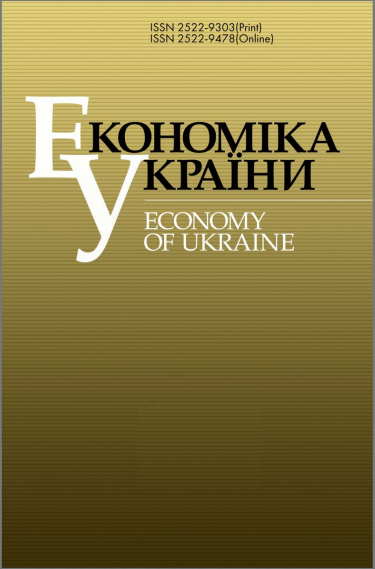ПОТЕНЦІАЛ ДИСТАНЦІЙНИХ МОДЕЛЕЙ ЗАЙНЯТОСТІ ПІД ЧАС КРИЗ НЕСТАБІЛЬНОСТІ
DOI:
https://doi.org/10.15407/economyukr.2024.02.047Ключові слова:
дистанційна зайнятість; мобільна зайнятість на базі ІКТ; продуктивність праці; робота вдома; соціальна безпекаАнотація
Розглянуто особливості використання нестандартних моделей зайнятості, що розвиваються на базі ІКТ, зокрема дистанційної роботи. Підкреслено, що ті, хто працюють віддалено, завдяки використанню нових інформаційних технологій з доступом до Інтернету можуть виконувати робочі обов’язки в будь-якому місці, що дозволяє зменшити соціальні ризики. Зайнятих, відповідно до їхніх посадових обов’язків і робочих функцій, умовно поділено на три групи: 1) ті, хто зазвичай працюють дистанційно вдома чи в будь-якому іншому місці, 2) ті, хто інколи виконують роботу дистанційно, 3) ті, хто ніколи не працюють віддалено.
Проаналізовано динаміку у країнах ЄС частки зайнятих осіб, які зазвичай працювали вдома, досліджено їхній розподіл у різних країнах Європи за означеними групами. Для України оцінено потенціал дистанційної зайнятості на основі статистичної інформації щодо кількості працівників на підприємствах, які використовували комп’ютери з доступом до Інтернету. Проведено аналітичну оцінку можливостей оснащення новими технологіями і ефективності їх використання на великих, середніх і малих підприємствах України.
Визначено зв’язок дистанційної зайнятості й ефективності праці на основі результатів економічних досліджень і соціологічних опитувань, проведених як в Україні, так і в інших країнах світу. Доведено, що для висококваліфікованих працівників зв’язок цієї форми зайнятості з продуктивністю є позитивним. Кризи нестабільності актуалізували питання адекватної адаптації національного ринку праці до функціонування в умовах невизначеності. Дистанційна зайнятість у цих умовах є інструментом, здатним підтримати соціальну безпеку під час криз і виступити потенціалом майбутнього розвитку національної економіки.
Посилання
Huk, L. (2021). Standard and New Forms of Employment: Diversification of Opportunities in the Context of Digitalization and Globalization. Business Inform. No. 1. P. 224-231. https://doi.org/10.32983/2222-4459-2021-1-224-231 [in Ukrainian].
Blyzniuk, V., Huk, L. (2020). Potential of change in the labor market trends: regional aspects. State and regions. Series: Economics and Business. No. 4(115). P. 112-119. https://doi.org/10.32840/1814-1161/2020-4-20 [in Ukrainian].
Kazekami, S. (2020). Mechanisms to improve labor productivity by performing telework. Telecommunications Policy. Vol. 44. Iss. 2, 101868. https://doi.org/10.1016/j.telpol.2019.101868
Rupietta, K., Beckmann, M. (2018). Working from Home. Schmalenbach Business Review. Vol. 7. Iss. 1. 25-55. https://doi.org/10.1007/s41464-017-0043-x
Emanuel, N., Harrington, E. (2023). Working Remotely? Selection, Treatment, and the Market for Remote Work. Federal Reserve Bank of New York Staff Reports. No. 1061, May. 97 p. https://doi.org/10.2139/ssrn.4466130
Golden, T., Gajendran, R. (2019). Unpacking the Role of a Telecommuter’s Job in Their Performance: Examining Job Complexity, Problem Solving, Interdependence, and Social Support. Journal of Business and Psychology. 34. 55-69. https://doi.org/10.1007/s10869-018-9530-4
Criscuolo, C., Gal, P., Leidecker, T. et al. (2021). The role of telework for productivity during and post-Covid-19: Results from an OECD survey among managers and workers. OECD Productivity Working Papers. No. 31. 67 p. https://doi.org/10.1787/7fe47de2-en
##submission.downloads##
Опубліковано
Як цитувати
Номер
Розділ
Ліцензія
Авторське право (c) 2024 Видавничий дім "Академперіодика" НАН України

Ця робота ліцензується відповідно до Creative Commons Attribution-NonCommercial-NoDerivatives 4.0 International License.



